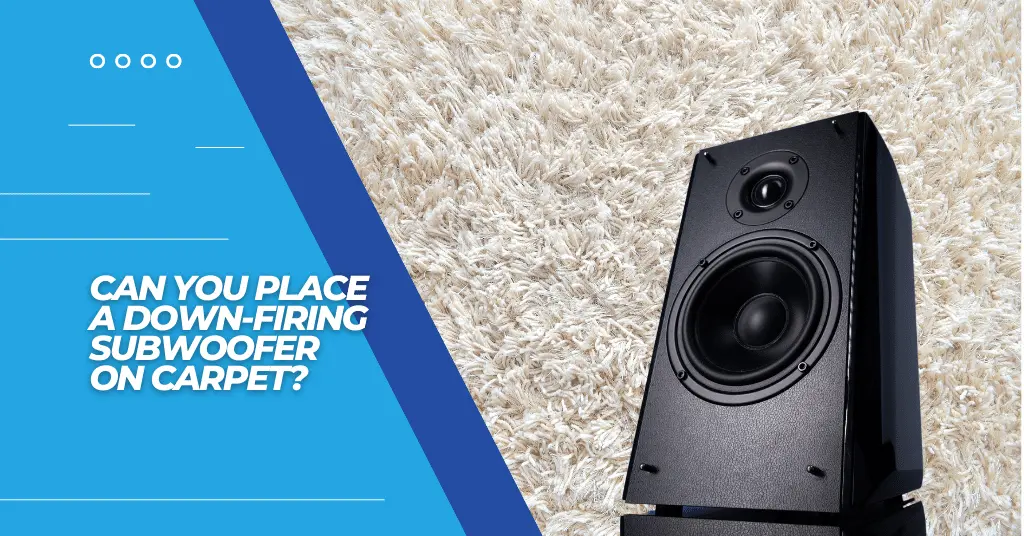Can You Place a Down-Firing Subwoofer on Carpet?

Many audiophiles consider down-firing subwoofers a substantial addition to any sound system that delivers deep, resonant bass frequencies.
As judged by the name, a down-firing sub sends waves toward the floor, creating an immersive, room-filling sound throughout the room.
However, their performance can be debated when someone places on a carpet. I’ve seen people arguing that carpets absorb sound waves, dampening the audio output.
At the same time, some audiophiles have discovered the better bass performance by having a cushion effect of the carpet on their down-firing subwoofers.
As a subwoofer expert, I will provide you with some facts and tips if you want to place your down-firing subwoofers on the carpet. Let’s begin!
What Is a Down-Firing Subwoofer?
Let’s understand the definition first! A down-firing sub is a type of loudspeaker that emits sound downwards towards the floor. This design utilizes the surface underneath to distribute low-frequency sounds evenly across the room.
In this design, the subwoofer driver is placed just a few inches above the ground to make the cone move freely without even hitting the floor.
In this way, the sound creates a unique listening experience, often described as “room-filling”. Whereas, front firing sub works by directing the bass waves toward the listening area.
Should I Place a Downward-Firing Subwoofer on the Carpet?
Yes, you can place a down-firing subwoofer on carpet. In some cases, I have seen this placement can really enhance bass response, thanks to the carpet’s diffusing properties, and reduce vibrations due to its dampening effect.
However, you may face a slightly muffled sound or uneven bass distribution if the carpet is dense or thick. In this case, you can adjust the subwoofer settings to compensate for any acoustical changes caused by the carpet.
I would just say that It’s all about finding a balance between the improved bass and potential challenges, so don’t hesitate to experiment with placement and settings to optimize your sound experience.
Pros & Cons of Placing a Down-Firing Sub on the Carpet:
I don’t know precisely about your room acoustics, floor types, and carpet thickness; therefore, the pros and cons that I am stating may vary. According to my experience, I have found the below advantages and disadvantages of the down-firing subwoofers on the different carpets:
Pros:
Let’s begin with the positive things.
1. Enhanced Bass Response:
When you place a down-firing sub on a carpet, it utilizes the surface as an acoustic amplifier. The downward-directed sound waves hit the rug and are diffused evenly across the room, enhancing the bass response.
The carpet fibers act as miniature absorbers, reducing the effect of standing waves or ‘room boom’, an unwanted resonance caused by sound waves bouncing off hard surfaces.
This effectively results in a smoother, more profound, and more immersive bass experience. Furthermore, the carpet isolates the subwoofer, minimizing vibrations that could lead to sound distortion and improving overall sound quality.
2. Subtle Aesthetics:
Not applicable to everyone’s scenario, but a down-firing sub can be a savvy choice for maintaining a subtle aesthetic balance within a room if placed on the carpet.
This orientation and the carpet’s sound-dampening nature help preserve the room’s visual appeal. The subwoofer may become less noticeable due to its low profile design and dark color, often matching some carpets.
Consequently, it effortlessly blends into the overall decor, becoming an almost unnoticeable part of the room. Therefore, a down-firing sub is a stylish and practical solution for individuals looking for an aesthetically pleasing sound system setup.
3. Vibration Dampening:
As mentioned above, the carpet acts as a vibration dampener, absorbing some energy. This absorption decreases the chances of unwanted resonance or rattles from other objects in the room.
Consequently, the audio quality is enhanced as distortions are minimized. By directing the powerful bass frequencies downwards, the down-firing subs also prevent these vibrations from being directly transmitted to nearby walls or furniture.
4. Reduced Boundary Interference:
The one that not many experts will tell you about. The soft texture of the carpet absorbs some of these sound waves, reducing the amount of sound reflected back toward the subwoofer.
This minimizes the possibility of the reflected sound waves interfering with the outgoing sound waves, a phenomenon known as boundary interference.
As a result, the sound produced by the subwoofer is cleaner and more precise, without the distortions that can occur with boundary interference.
5. Softened Impact Sounds:
If you’re someone who likes to hear soft bass, then this absorption effect is efficient for low-frequency sounds like those produced by a subwoofer. As a result, the bass impact is softened, reducing the noise transmission to other rooms or floors.
This method not only helps with noise control but also contributes to a more immersive audio experience, as it promotes the even dispersion of sound waves throughout the room.
Cons:
Now let’s discuss some of the adverse effects:
1. Muffled Sound:
Where we have so many beneficial effects, you may also face some negative ones. When you place a down-firing subwoofer directly on a thick or dense carpet, the carpet absorbs much of this sound.
This absorption, particularly of the key bass frequencies, leads to a perceived loss of clarity and definition. Essentially, the carpet acts as a dampener, causing the sound to appear muffled or less defined.
Therefore, if you’ve noticed less articulate bass after placing your down-firing subwoofer on a carpet, it’s likely due to this absorption effect.
2. Reduced Energy Transfer:
When you position the downward-firing sub on a carpet, the carpet fibers partially absorb some of the energy. Most carpets’ thick, smooth surfaces act as a form of insulation, reducing the energy that reaches the room and thus dampening the sound.
Furthermore, the uneven surface of the carpet can scatter the frequency waves, causing a further reduction in perceived loudness. It’s akin to placing a barrier between the sound source and the listener, leading to a less efficient transfer of sound energy.
3. Potential for Unwanted Resonance:
In some cases, I have observed the unwanted resonance from the down-firing subs on the carpets. This resonance can result in the rug essentially becoming an unintended amplifier, which could alter the bass quality.
Further, if the subwoofer is not isolated correctly, it could cause sympathetic vibrations in the room’s structure, leading to additional sound colorations.
However, you can avoid this by using a sturdy, high-density platform between the subwoofer and the carpet, such as a subwoofer isolation pad. This would help reduce the transmission of unwanted vibrations to the rug and the room.
Can You Place Your Down-Firing Subwoofer on Concrete Floor Too?
Yes, you can place your down-firing subwoofer on a concrete floor. However, you should not ignore the hard surface effect on the sound quality.
Concrete floors could cause reflections, leading to a boomy or muddled audio output. To mitigate this, you can use an isolation pad or a subwoofer spike to create a level of separation between the concrete floor and the subwoofer.
This will help reduce unwanted vibrations and improve overall sound performance, providing a cleaner and tighter bass response.
Which Placement Should You Consider for the Down-Firing Sub: Carpet or Concrete Floor?
Well! That’s a very tricky question that I have to face (Whether to choose carpet or concrete floor). Deciding between carpet and concrete for your down-firing subwoofer positioning, you should consider your personal needs and circumstances.
As mentioned above, carpet placement can enhance bass response and reduce vibrations, but it may lead to muffled sound and offer less flexibility in order.
On the other hand, a concrete floor (with the isolation pad between) provides a stable surface for precise bass performance and easy home theater room calibration.
It also reduces the risk of unwanted resonances and allows more leeway in subwoofer placement. However, it may propagate impact sounds through the floor.
Therefore, carpet might be your best bet if you’re striving for a more immersive bass experience and are okay with the potential for a muffled sound. Conversely, concrete could be the ideal choice if you’re seeking precise bass performance and room calibration.
Tips for Optimal Down-Firing Subwoofer Performance on Carpet:
Here are a few farewell tips from me if you’re going with the on-the-carpet subwoofer placement:
- Strategic Placement: Carpets can absorb sound vibrations, diminishing the subwoofer’s impact. However, when placed strategically, the subwoofer’s sound waves can evenly disperse throughout the room despite the carpet’s absorption. By experimenting with different placements along walls or corners, you can find a location that offers a balanced bass response, thus circumventing the sound-dampening effects of the carpet.
- Room Calibration: The calibration tools or software adjusts the subwoofer’s settings to improve music quality. The sound may be muffled or uneven, detracting from the audio experience without calibration. Hence, I recommend you follow room calibration guidelines when positioning your subwoofer to enjoy optimal sound.
- Isolation Pads: You can still use rubber pads if you have a thick or dense carpet. This helps maintain cleaner and more precise bass output. The vibrations can distort the sound and reduce the overall audio quality. Using these pads ensures that the subwoofer performs at its optimal level, providing you with the best possible sound experience.
- Subfloor Material: The subfloor material can significantly impact audio quality. Certain materials can absorb or reflect bass frequencies, altering the audio experience. Harder subfloor materials like concrete or hardwood may reflect sound directly, creating a more resonant bass. Conversely, softer materials like foam or particleboard may absorb frequencies, potentially dampening the sound.
General FAQs
Can You Place a Hard Tile Between the Down-Firing Subwoofer & Carpet?
Yes, placing a hard tile between a down-direction subwoofer and a carpet can actually improve sound quality. The tile provides a solid, flat surface that prevents the subwoofer’s vibrations from being absorbed by the rug. This results in a cleaner, more precise bass response, enhancing your overall audio experience.
Can You Put a Subwoofer on the Floor?
Ideally, subwoofers should not be placed directly on the floor. This position can cause excessive vibration and potentially damage the equipment or distort the sound. Instead, they can be elevated or placed on a pad designed to absorb vibrations. However, if floor placement is the only option, consider using isolation pads to minimize potential issues.
Can You Position a Down-Firing Subwoofer on the Isolation Pads?
Yes, you can position a down-firing subwoofer on the isolation pads. These pads are designed to decouple the subwoofer from the floor, reducing vibrations and improving audio quality.
Can I Place My Down-Firing Subwoofer on Any Type of Carpet?
Yes, you can place your down-firing subwoofer on any type of carpet. However, very thick or plush carpets might dampen the sound vibrations. To achieve the best audio performance, consider using a dense subwoofer pad or a platform underneath to prevent proper absorption.
How Do I Prevent the Subwoofer From Damaging the Carpet?
The most effective way to prevent most down firing subwoofers from damaging your carpet is to place them on a isolation pad or a rubber mat. These products are designed to absorb the subwoofer’s vibrations, reducing the wear and tear on your carpet.
Can I Place Other Speakers on Top of the Subwoofer if It’s on the Carpet?
Generally, I won’t recommend placing other speakers on top of the subwoofer, even if it’s on the carpet. Although it might seem convenient, this setup could result in unwanted vibrations that may distort the sound from both the subwoofer and the speakers, negatively affecting the overall music quality.
